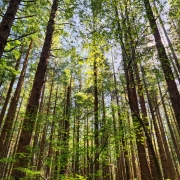Living Light - Bioluminescence
July 1, 2005 | Dan Harrison
It’s about that time of year again, warm clear nights, bonfires on the beach and of course those long strolls down to the waters edge to splash your toes in the water and watch it light up like a Las Vegas fountain. Though commonly referred to as phosphorescence, these sparkling waters are actually a result of bioluminescence! (bye-oh-loo-meh-neh- sens) Bioluminescence refers to light that is produced by an organism through a chemical reaction. Bio meaning ‘living’ and luminescence meaning ‘light’, hence ‘living light’.
The bioluminescence we commonly see lighting up the night surf are usually caused by dinoflagellates, a single-celled plant-like organism. When agitated the dinoflagellates produce their famous ‘flashes’ through a chemical reaction that occurs when a molecule, called luciferin, is mixed with an enzyme, called luciferase, in the presence of oxygen (lucifer, meaning ‘light bringing’). The result is a blue-green flash that usually lasts less than a second.
As much as we love these beautiful summer light shows, animals in the ocean may see things a little differently. Imagine trying to remain inconspicuous amongst these luminescent minefields! Any inadvertent motion could set off an ‘explosion’ of light and catch the attention of a lurking predator.
It is thought that dinoflagellates use their ‘flash’ as a sort of burglar alarm to momentarily blind their predators and provide them with an escape opportunity. While organisms such as the dinoflagellates create light to escape predators, others luminesce for reasons such as attracting mates and obtaining prey. Deep-sea predators like the anglerfish for example, dangle a light from their forehead as a lure to capture fish.
On land, bioluminescence is most commonly seen in glowing fungi, fireflies and a few other families of luminous insects. While bioluminescent organisms light up and amaze people around the world, they’ve remained primarily a marine phenomenon. In fact, bioluminescence is the predominant source of light in the deep ocean. In these great depths, it is thought that as much as 90% of the inhabitants are capable of producing light!
As the water temperatures rise and the warmth of the sun returns, these fair-weather plankton begin showing up in abundance. If you’re one for flashy shows, this is a great time of year to get out and enjoy these living lights!



